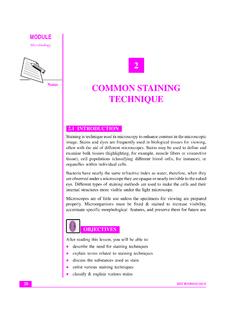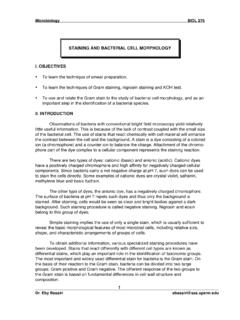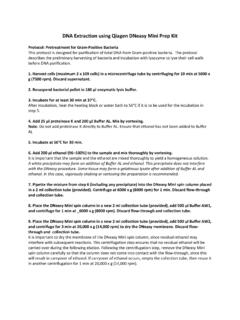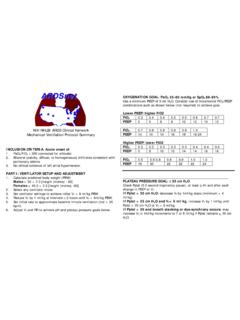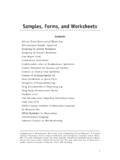Transcription of CAUTI.ppt
1 1 2 3 Using this module means that you must use active, patient-based, prospective surveillance of CAUTIs and their corresponding data which is confirmed by a trained infection control professional (ICP). This means that the ICP shall seek out infections during a patient s stay by screening a variety of data sources, such as laboratory, pharmacy, admission/discharge/transfer and radiology/imaging, and pathology databases, patient charts, including history and physical exam notes, nurses/physician notes, temperature charts, etc. Others may be trained to screen data sources for these infections, but the ICP must make the final determination. Laboratory-based surveillance should not be used alone, unless all NHSN criteria for identifying an infection are solely determined by laboratory evidence.
2 Retrospective chart reviews should be used only when patients are discharged before all information can be gathered 4 This slide illustrates the basic structure of the Patient Safety Component of NHSN. The Device-associated Module is shown at the top of the diagram in red. This is the module in which the catheter-associated urinary tract infection protocol can be located. 5 This slide illustrates the further breakdown of the Device-associated module. There are five separate options in this module: Central Line-associated Bloodstream Infections (CLABSI), Ventilator-associated Pneumonia (VAP) Catheter-associated Urinary Tract Infection (CAUTI), Central Line Insertion Practices (CLIP) and Dialysis Event (DE). We will discuss only catheter-associated urinary tract infection during this session. 6 UTI is the most common site of healthcare-associated infection more than 30% of all HAIs reported by acute care hospitals.
3 Almost all are caused by instrumentation of one kind or another the indwelling catheter is the most common type of instrumentation. Complications from CAUTI include: Discomfort Prolonged hospital stay Increased cost- Note also that the Centers for Medicare and Medicaid Services no longer reimburse hospitals for costs associated with the development of HAI CAUTIs. The CDC/HICPAC Guideline for Prevention of Catheter-associated Urinary Tract Infection gives recommendations for the proper management of patients with indwelling urinary catheters. If followed, these measures can reduce the problem of catheter-associated UTIs. The link to the guideline is at the bottom of the screen. 7 In order to clearly understand CAUTI surveillance, there are certain definitions that must be clearly understood. These are: CAUTI, Indwelling catheter, and definitions for specific infection types which include SUTI, ABUTI, and OUTI.
4 Please note that Asymptomatic Bacteremia (ASB) is no longer a CDC/NHSN specific infection type. ASB was deleted in January of 2009 and cannot be reported to NHSN. 8 had an indwelling urethral urinary catheter in place within the 48 hour period A catheter-associated urinary tract infection is a UTI that occurs in a patient who had an indwelling urethral urinary catheter in place within the 48 hour period before the onset of the UTI. If the UTI develops in a patient within 48 hours of discharge from a location, indicate the discharging location on the infection report, not the current location of the patient. This is known as the Transfer Rule. 9 10 An indwelling catheter is a drainage tube that is inserted into the urinary bladder through the urethra, is left in place, and is connected to a closed collection system Also called a Foley catheter Does not include straight in and out catheters or urinary catheters that are not placed in the urethra.
5 11 12 We will discuss ABUTI later, but for now, let s discuss the first specific infection type which is the Symptomatic UTI. As the title suggests, this is a UTI in a patient who demonstrates clinical symptoms as well as having laboratory evidence of the UTI. (Remember ASB is no longer an CDC/NHSN infection) There are 4 criteria, and criteria 1 and 2 are further subdivided into an a and b category. The criteria numbered 1 and 3 have a urinary culture positive for 105 CFU/ml. The criteria numbered 2 and 4 have a urinary culture positive for 103 and <105 CFU of organism/ml. Because of this lower colony count, supportive urinalysis is required and this will be covered in a few moments.
6 You will notice that there are age parameters for each of the criteria: Any age patient can meet criteria 1-2, but only children 1 year of age can meet criteria 3 or 4. Also, the urine cultures can have no more than 2 microorganisms present. Criteria 3 and 4 are for children 1 year of age or less and may or may not be associated with a catheter. 13 Criteria 1 and 2 are subdivided into a and b dependent upon the presence or absence of an indwelling catheter in the 48 hours prior to urine specimen collection. The reason for this will become apparent when we discuss symptomatology. The a criteria both 1a and 2a, involve patients that had catheters in place within the 48 hours prior to the specimen collection. The b criteria both 1b and 2b, involve patients that did not have catheters in place within the 48 hours prior to specimen collection.
7 Criteria 3 and 4 are for children 1 year of age or less and may or may not be associated with a catheter in the 48 hours prior to specimen collection. 14 Notice that the symptoms that comprise each criteria depend on whether the catheter was in place at the time of specimen collection or removed prior it. Urgency, frequency, and dysuria are not included in the criteria for a patient with an indwelling catheter at the time of specimen collection, because these symptoms are often a result of the catheter itself rather than the presence of a UTI. This distinction is the basis for 1a being subdivided. 15 Likewise, you will note that criterion 2a is exactly the same as criterion 1a with the exception that 2a requires fewer organisms and therefore also requires supportive evidence in the way of a positive urinalysis with at least one of the following: Positive dipstick for leukocyte esterase and/or nitrite Pyuria (urine specimen with 10 WBC/mm3 or 3 WBC/high power field of unspun urine) Microorganisms seen on gram stain of unspun urine Again, if the catheter was in place at the time of specimen collection, then urgency, frequency and dysuria are not acceptable criteria for SUTI (2a).
8 16 You can actually use the previous criteria for any patient, but this slide shows criteria that may be used in infants and neonates. The symptoms that we see in adults are often different from those we see in small children. An infant, for example, can demonstrate hypothermia, bradycardia or apnea. This criteria can only be used for infants and neonates those patients younger than 12 months of age. Note that the difference between Criteria 3 and 4 is the number of colony forming units of organisms cultured from the urine. 17 18 19 an indwelling urethral urinary catheter in place within the 48 hour period before the We said that the definition of a CAUTI was a UTI that occurs in a patient who had an indwelling urethral urinary catheter in place within the 48 hour period before the onset of the UTI.
9 Therefore, patients that did not have such a catheter cannot meet the definition of a CAUTI. They may develop a HA UTI, but it will not be a catheter associated UTI (CAUTI). This means that the only NHSN criteria that are catheter associated are: 1a, 2a, and, if there is has been a catheter in place in the required time period, criteria 3, 4, and ABUTI. As the footnote indicates, the CDC criteria 1b and 2b, and the NHSN specific event Other UTI (or OUTI), are not associated with indwelling urinary catheters and, therefore, are not used to identify CAUTIs and cannot be used in CAUTI rate analysis. 20 21 Denominators for CAUTI are collected much like they are for other monitored devices. For all locations (other than NICU), at the same time each day, the number of patients and the number of patients with indwelling urinary catheters are recorded 22 23 This is the formula that is used to calculate the CAUTI rate for a given unit.
10 24 The Device Utilization Ratio gives us a measure of how much urinary catheters are used on a given unit The DU ratio is calculated by dividing the number of ventilator days by the number of patient days. 25 This an example of CAUTI Analysis that was performed in NHSN. This is a CAUTI Rate Analysis for a specific time period of your choice. The analysis documents the units being monitored, the number of CAUTIs on the unit, the number of indwelling cath or device days, the calculated CAUTI rate for each unit , the NNIS/NHSN CAUTI pooled mean for comparison the Indwelling Catheter Utilization Ratio for that unit and the NNIS/NHSN DU rate for comparison 26 27










